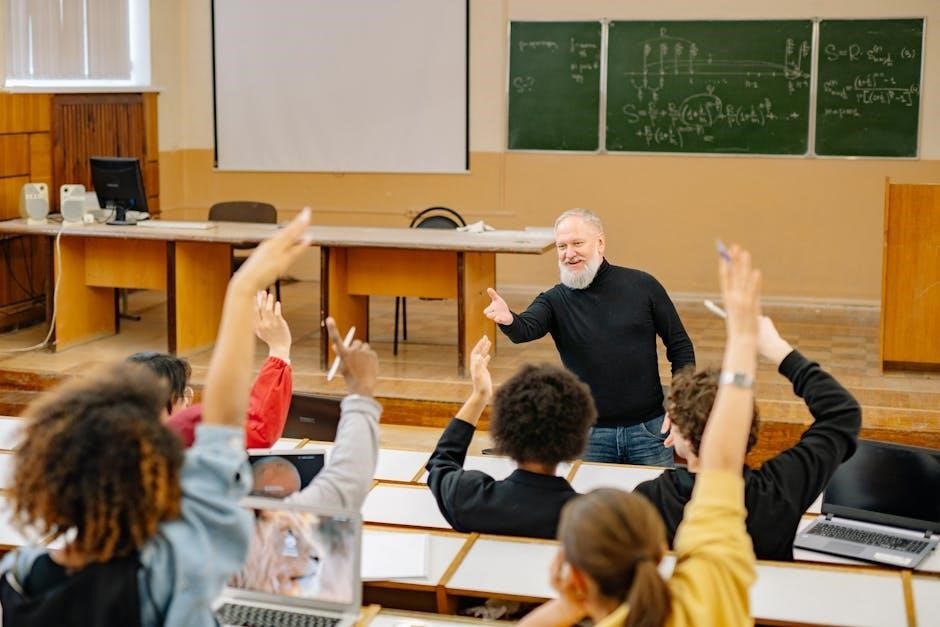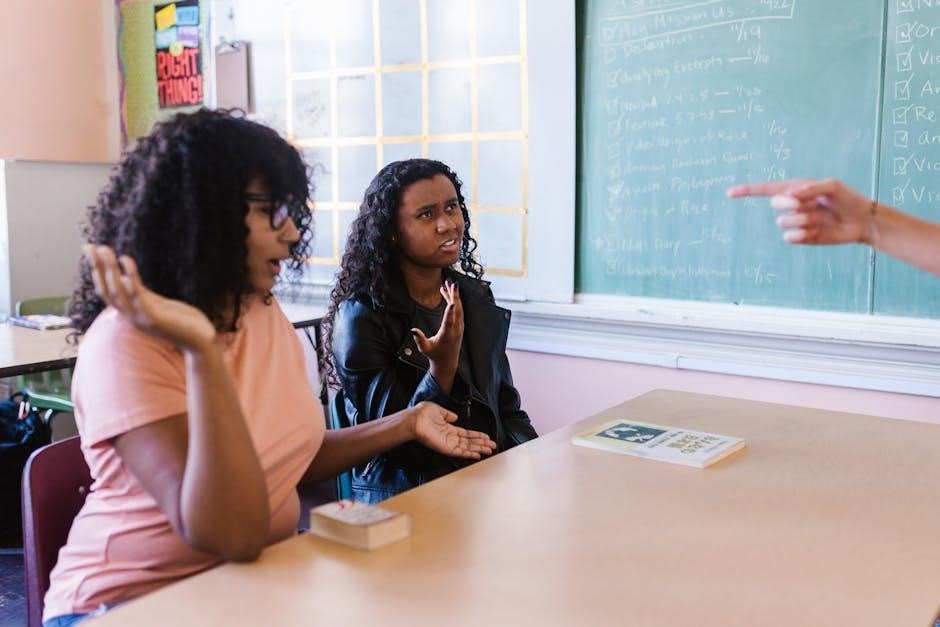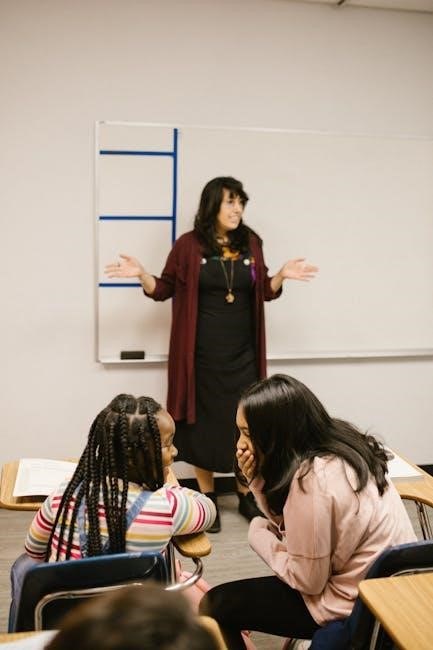
Preparing for a special education teacher interview requires understanding key questions and strategies. This section provides insights into common queries and tips for success‚ emphasizing the STAR method and differentiated instruction techniques to address diverse student needs effectively.
1.1 Overview of the Importance of Preparation
Preparation is crucial for special education teacher interviews‚ as it demonstrates professionalism and readiness. Understanding common questions‚ such as those about classroom management and differentiated instruction‚ helps candidates showcase their skills. Practicing responses using the STAR method ensures clarity and confidence. Reviewing topics like behavioral support and collaboration with parents highlights a candidate’s ability to meet the unique demands of this role effectively.
1.2 Key Areas to Focus On During Preparation
Focus on understanding the STAR method for answering behavioral questions‚ preparing examples of differentiated instruction‚ and showcasing classroom management strategies. Research the school’s approach to special education and review common interview questions. Practice discussing collaboration with parents and colleagues‚ as well as the use of assistive technology. Aligning your preparation with these areas ensures a comprehensive and confident presentation of your qualifications and experiences.
Common Special Education Teacher Interview Questions
Expect questions about classroom management‚ differentiated instruction‚ and behavioral strategies. Be ready to discuss your teaching philosophy‚ collaboration with parents‚ and use of assistive technology.
2.1 Introductory Questions
Introductory questions assess your background‚ motivation‚ and teaching philosophy. Expect queries like‚ “Tell me about yourself‚” “What inspired you to become a special education teacher?” or “Describe your educational background.” These questions help interviewers understand your passion for special education and your readiness to support diverse learners. Be prepared to highlight your experiences‚ training‚ and commitment to fostering inclusive education. Use the STAR method to structure your responses clearly and confidently.
2.2 Role-Specific Questions
Role-specific questions focus on your experience and strategies for teaching students with special needs. Examples include‚ “How would you handle a challenging behavior in the classroom?” or “Describe your approach to creating individualized education plans.” These questions assess your ability to manage diverse learning needs‚ collaborate with support teams‚ and implement effective teaching strategies. Be ready to provide detailed examples using the STAR method to demonstrate your expertise and problem-solving skills in special education settings.
2.3 Behavioral and Scenario-Based Questions
Behavioral and scenario-based questions assess how you handle real-life challenges in special education. Examples include‚ “How would you manage a student with severe behavioral difficulties?” or “Describe a strategy for supporting a student with autism during a transition.” These questions evaluate your problem-solving skills‚ adaptability‚ and ability to apply effective strategies in complex situations. Prepare by recalling specific experiences and using the STAR method to articulate your responses clearly and confidently.

The STAR Method for Answering Interview Questions
The STAR method helps structure responses to behavioral questions‚ detailing Situation‚ Task‚ Action‚ and Result. It ensures clarity and effectiveness in showcasing your problem-solving skills and experiences.
3.1 Understanding the STAR Framework
The STAR method (Situation‚ Task‚ Action‚ Result) is a structured way to answer behavioral questions. It helps candidates clearly articulate their experiences by setting the context‚ describing their role‚ explaining their actions‚ and sharing the outcome. This framework ensures responses are concise‚ focused‚ and highlight problem-solving skills. For special education roles‚ it’s particularly useful for showcasing classroom challenges and successes‚ making it easier for interviewers to assess your teaching strategies and impact.
3.2 Applying STAR to Special Education Scenarios
When applying the STAR method to special education scenarios‚ focus on clearly describing a specific classroom situation‚ the task you faced‚ the actions you took to address it‚ and the positive result. For example‚ discuss how you supported a student with behavioral challenges or implemented an IEP. This structured approach helps highlight your problem-solving skills and commitment to student success‚ making your responses memorable and impactful during interviews.

Classroom Management Strategies
Effective classroom management involves creating a structured‚ supportive environment with clear expectations and positive reinforcement to ensure all students‚ including those with special needs‚ thrive behaviorally and academically.
4.1 Discipline and Behavioral Support
Discipline in special education requires a proactive approach‚ focusing on positive reinforcement and individualized behavior plans. Techniques like clear communication‚ consistent routines‚ and restorative practices help students manage emotions and develop self-regulation skills. Understanding each student’s triggers and needs allows for tailored interventions‚ fostering a respectful and inclusive classroom environment that encourages social and academic growth.
4.2 Creating an Inclusive Learning Environment
Creating an inclusive classroom involves adapting instruction to meet diverse needs‚ fostering respect‚ and ensuring all students feel valued. Strategies include differentiated instruction‚ flexible grouping‚ and incorporating assistive technologies. Collaboration with parents and colleagues enhances support systems‚ while culturally responsive teaching promotes equity. Encouraging peer interactions and celebrating diversity further cultivate an environment where every student can thrive academically and socially.
Assessing Student Needs and Progress
Evaluating students’ needs and progress involves using differentiated instruction and educational assessments. Teachers adapt strategies to meet individual learning requirements‚ ensuring measurable growth and tailored support for each student.
5.1 Differentiated Instruction Techniques
Differentiated instruction involves tailoring teaching methods to meet individual student needs. Techniques include tiered assignments‚ learning centers‚ and technology integration. Teachers modify content‚ process‚ and product to ensure accessibility. Using assessments‚ educators identify learning gaps and adapt strategies. For example‚ providing visual aids for visual learners or extra support for students with disabilities. This approach ensures all students‚ including those with special needs‚ receive personalized instruction that fosters growth and understanding.
5.2 Tools for Measuring Student Development
Teachers use various tools to measure student progress‚ such as IEP goals‚ progress monitoring‚ and formative assessments. Standardized tests and portfolios also track development. Technology tools like DIBELS and curriculum-based measurements provide data-driven insights. These tools help identify learning gaps and measure growth over time‚ ensuring tailored instruction and support for diverse learners‚ especially those with special needs‚ to achieve their educational objectives effectively.

Collaboration with Parents and Colleagues
Effective communication with parents and colleagues is crucial. Strategies include regular updates‚ team meetings‚ and clear dialogue to ensure a united approach to student support and success.
6.1 Communicating with Parents
Communicating with parents is vital for student success. Strategies include regular updates‚ active listening‚ and empathy. Be prepared to discuss how you involve parents in their child’s education‚ address concerns‚ and translate complex jargon into clear language. For example‚ explaining IEP goals or progress reports in an accessible way fosters trust. Highlight your ability to collaborate and provide emotional support‚ ensuring parents feel valued and informed about their child’s development and needs.
6.2 Team Teaching and Professional Collaboration
Team teaching and professional collaboration are essential for creating a cohesive educational environment. Highlight your ability to work with general education teachers‚ specialists‚ and support staff to ensure all students receive tailored support. Emphasize clear communication‚ active listening‚ and mutual respect. Discuss how collaboration enhances lesson planning‚ student progress‚ and overall educational outcomes‚ ensuring a unified approach to meeting diverse student needs effectively.

Technology in Special Education
Technology plays a vital role in special education‚ offering tools like assistive devices and digital platforms to enhance learning and engagement for students with diverse needs.
7.1 Assistive Technology for Students
Assistive technology is crucial for students with disabilities‚ providing tools like speech-to-text software‚ adaptive keyboards‚ and communication devices. These technologies enhance accessibility‚ enabling students to engage fully in learning. Special education teachers should be familiar with such tools‚ as they help bridge gaps for students with varying needs‚ ensuring an inclusive and effective educational environment. Understanding these technologies is essential for modern special education practice.
7.2 Digital Tools for Lesson Planning
Digital tools like Google Classroom‚ Microsoft Teams‚ and educational apps streamline lesson planning for special education teachers. These platforms allow for personalized learning plans‚ interactive activities‚ and real-time progress tracking. Tools such as IEP management software and multimedia resources enhance engagement and cater to diverse learning needs. Leveraging these technologies ensures efficient‚ tailored instruction and fosters collaboration with parents and colleagues‚ creating a cohesive educational environment.
Advocating for Students and Inclusivity
Advocating for students ensures equitable education and fosters inclusivity. Teachers must address individual needs‚ promote diversity‚ and support policies that enhance learning opportunities for all students.
8.1 Promoting Equity in Education
Promoting equity in education involves creating inclusive environments where all students‚ regardless of abilities‚ receive equal opportunities. Special education teachers must advocate for resources‚ modify curricula‚ and use differentiated instruction to ensure every student’s needs are met. This approach fosters a culture of respect‚ enabling students to thrive academically and socially. Equity ensures that no student is left behind in their educational journey.
8.2 Addressing Individual Learning Needs
Addressing individual learning needs requires tailored strategies to support diverse abilities. Special education teachers use differentiated instruction‚ assistive technology‚ and adaptive tools to accommodate unique requirements. By identifying specific needs through assessments and IEPs‚ educators ensure each student accesses the curriculum meaningfully. This personalized approach fosters inclusivity‚ enabling students to reach their full potential and achieve academic success.

Professional Development and Growth
Continuous learning and staying updated on best practices are crucial for special education teachers. Engaging in professional development ensures they can effectively address diverse student needs and adapt strategies.
9.1 Continuous Learning Opportunities
Continuous learning is vital for special education teachers to stay updated on effective strategies and technologies. Engaging in workshops‚ conferences‚ and online courses helps refine skills‚ ensuring they can address diverse student needs. Utilizing resources like PDF guides with interview questions and answers also aids in preparing for professional growth and demonstrating commitment to ongoing development.
9.2 Staying Updated on Best Practices
Staying updated on best practices ensures special education teachers provide effective support. Continuous learning through workshops‚ webinars‚ and educational resources like PDF guides helps adapt to new strategies and technologies. Regularly reviewing special education teacher interview questions and answers pdfs also keeps professionals informed about current trends‚ enabling them to address diverse student needs and maintain high educational standards in their classrooms.

Salary Expectations and Job Market Trends
Discussing salary expectations and job market trends is crucial. Research shows salary ranges vary by location‚ experience‚ and school type. Special education teachers are in demand‚ with growing job opportunities. Utilize PDF guides to understand compensation factors and negotiate confidently based on qualifications and regional standards.
10;1 Understanding Salary Ranges
Understanding salary ranges for special education teachers is crucial for negotiation. Salaries vary by location‚ experience‚ and school type‚ with national averages providing a baseline. Research regional standards and utilize PDF guides to gain insights into compensation factors. This knowledge helps candidates set realistic expectations and negotiate effectively during interviews‚ ensuring fair pay based on qualifications and market trends;
10.2 Factors Influencing Compensation
Compensation for special education teachers is influenced by location‚ experience‚ and school type. Urban areas may offer higher salaries‚ while rural regions often provide additional incentives. Certifications‚ advanced degrees‚ and specialized skills in areas like assistive technology can also enhance pay. Understanding these factors helps candidates negotiate effectively and align expectations with market standards‚ ensuring fair compensation for their expertise and dedication to special education.
Effective preparation and confidence are key to acing special education teacher interviews. Practice the STAR method‚ review common questions‚ and highlight your experiences to stand out and succeed.
11.1 Summarizing Key Preparation Strategies
Effective preparation involves researching common questions‚ practicing the STAR method‚ and reviewing personal experiences. Organize your thoughts‚ highlight your strengths‚ and align your philosophy with the school’s mission. Focus on showcasing your ability to adapt‚ collaborate‚ and support diverse learner needs. Confidence and clarity in your responses will demonstrate your readiness for the role and commitment to student success.
11.2 Final Advice for Success
Be authentic‚ passionate‚ and confident during your interview. Showcase your dedication to inclusivity and student growth. Research the school’s mission and align your responses accordingly. Practice answering questions using the STAR method to highlight your experiences effectively. Demonstrate adaptability‚ creativity‚ and a commitment to continuous learning. Remember‚ your enthusiasm and genuine care for students will leave a lasting impression and set you apart as an ideal candidate.